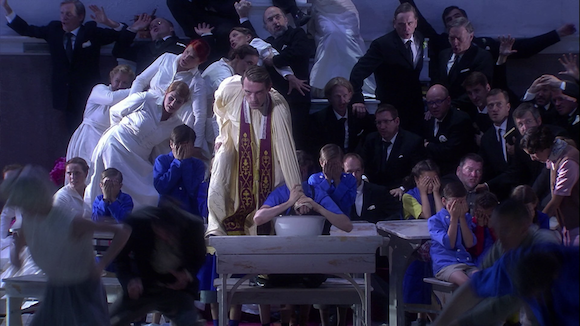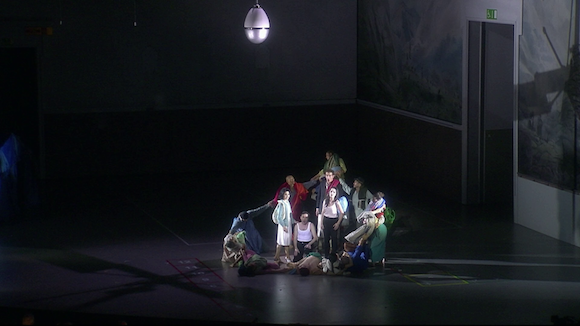I’m not really sure that it’s a good idea to take Rameau too seriously, especially a work like Les Indes galantes but that’s what Sidi Larbi Cherkaoui does in his production for the 2016 Münchner Opernfestspiel. As written, the piece has five separate parts; an allegorical prelude and four scènes, each telling a love story in an “exotic” setting; Turkey, Peru, Persia, among les sauvages of North America. It’s a spectacle but it uses the exotic settings to poke fun at certain aspects of Western culture in Rameau’s usual irreverent way. There’s no linking narrative and the characters in each scène (the goddesses Amour and Bellona aside) only appear once.

Cherkaoui sees the piece not just as a way of sending up European society but of exploring a range “opposites”; colonialism and immigration, civilization and primitivism, Europe and America (specifically the EU and the USA) as well, of course, as love and war. He uses several elements to do this. He introduces a group of children supernumeraries. The sets provide a kind of visual continuity between scenes and, most importantly, he uses the same singers in multiple roles and it’s clear from visual clues that they really continue to be the same character.

The piece opens with a classroom in which the goddess Hébé (Lisette Oropesa) is teaching a group of noisy children. There’s lots of action. This is true throughout. Cherkaoui, who is a choreographer first and director second, is not afraid to use his excellent Eastman dancers and to have the singers work with them (which they do remarkably well). There are lots of flags. The President of the USA makes a brief (silent) appearance when Bellona (Goran Juric) makes his entrance. Amour appears. We have set up out first two “opposites”; war and love and the EU and the USA.

In Le Turc généreux, much use is made of transparent boxes or carts which are wheeled around. There’s a public toilet with Amour (Ana Quintans) as concierge at the back of the stage. This mysteriously transforms into a confessional. Otherwise this is played pretty straight. Osman (Tareq Nazmi) is set up as the barbaric Turk who eventually reveals himself as more magnanimous than his European equivalent (cue Mozart) in allowing the lovers Émilie (Elsa Benoit) and Valère (Cyril Auvity) to be reunited. At the end of the scène the school desks are transformed into the pews of a chapel and we are off to Les Incas de Péroux.

Here we get a neat inversion. The temple of the Sun and it’s priest Huascar (François Lis) are represented as very high Catholic although he spends much of his time denouncing the Spanish religion for being just about gold. He is trying to dissuade the Inca princess Phani (Anna Prohaska) from marrying the Spaniard Don Carlos (Mathias Vidal). There’s a very funny bit where Huascar almost drowns Don Carlos in the font while marrying off several couples (but angrily turning away a same sex couple). Hébé and the kids reappear in the congregation. I found this Catholic inversion particularly interesting as it really does suggest the way Peruvian Catholicism has absorbed the traditional Inca religion. I wonder how much Rameau was aware of that but anybody who has visited the chapel to Jesus Christ of the Thunderstorm in Cuzco Cathedral will recognise it at once. At the end of the scene the “boxes” fro the first scène reappear, this time full of flowers, and we are on to Les Fleurs: Fête Persan.

This is a complicated little scene of mistaken identity and misunderstood intentions. In essence it’s simple. The prince Tacmas (Auvity again) and his vassal Ali (Tareq Nazmi again) are in love with each others’ slaves Zaire (Ana Quintans) and Fatime (Anna Prohaska) but Zaire has dressed herself as a man to test Ali but Tacmas takes her/him as a rival for Fatime and confusion ensues. There’s an interesting exploration of the idea of “constancy” with some really interesting choreography during the rather lovely aria Papillon inconstant.

It’s the final scène, Les sauvages, where things get much darker. We are in North America but not in some sort of Rousseauesque idyll. There’s a refugee camp and a wall with armed guards. The President of the USA is back in the character of Adario (John Moore). He stands atop a Trump like wall. The refugees have flags of EU countries but the armed guards (on Segway boards) are clearly American. Hébé (complete with the schoolkids) has been transformed into the princess Zima pursued by Adario. Huascar is back, still wearing a cross, as Don Alvaro and Don Carlos is back as Damon. It’s very violent with confusing fight scenes involving cleaning materials before some sort of sorting process takes place and the lucky few are admitted to the American paradise while the rest are hustled away by the guards. At the end parts of all the sets come together for the final chaconne to suggest some sort of order and unity.

It’s fascinating and a bit disturbing. Occasionally the didacticism seems heavy handed but most of the time it’s redeemed by the sheer energy of the action. As in all good Rameau productions the dance elements are fully integrated and very well done. There’s also very fine singing across the board. It’s not just fine, it’s idiomatic with a correct sense of style. Ivor Bolton is conducting from the harpsichord and he is totally at home here. He can make the music delicate or a bit vulgar as needed. Yes, there are musettes. The orchestra and chorus are excellent and everyone seems onboard. The singers are notably physical here. They dance, they climb on scenery, they get carried around by the dancers. There is no “park and bark”.

The technical package on Blu-ray is top notch. The picture is excellent and there’s vivid DTS-HD 5.1 sound. The video direction by Andy Sommer is not bad at all. I think it must be quite hard to film a production with so much going on but I think we see most of it. There’s a 14 minute making off documentary which frankly isn’t very enlightening except for an interview where the head set builder talks about trying to build stuff for a director who keeps changing his mind about how to use it! There’s a good essay by the director though in the booklet, as well as a synopsis and track listing. Subtitle options are English (occasionally incomprehensibly weird), French, German, Spanish, Korean and Japanese.

This is currently the only Les Indes galantes available on Blu-ray. DVD offers the much more light hearted but hardly politically correct Christie recording from Paris and a recording of the rather different Toulouse version from Les Talens Lyriques. It’s a welcome addition to the catalogue.

